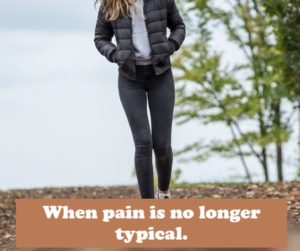We all know that pain initiates with a physical or mechanical injury and if you are breathing and moving in this world, you WILL experience pain from injury, it’s unavoidable.
 So, if pain is a normal process of life, why do some people just not seem to recover? There is now so much research that shows that our ability to recover from pain is dependent on so much more than just the tissue healing; in fact, in many people, pain may persist even in the absence of a mechanical cause.
So, if pain is a normal process of life, why do some people just not seem to recover? There is now so much research that shows that our ability to recover from pain is dependent on so much more than just the tissue healing; in fact, in many people, pain may persist even in the absence of a mechanical cause.
What? Does that mean your pain is just imagined? It sounds crazy but this is not an uncommon scenario; as health practitioners we can be guilty of portraying this perception even if unintended, simply by the language we use when describing injury and healing to our clients. Too often and often too quickly, scans are sought to identify the cause of lingering pain. The problem is, very rarely do scans show something significant. Most often they show up typical signs of aging and of wear and tear, but because pain is present, the association is made between what we see on the scan and the pain you might be feeling. The problem with this is, typical wear and tear is not going away and so a further association is made – “I’m never going to get better”, “I just have to live with this pain”, “I will never be able to enjoy the activities I have, that make life fun”.
So, lets step back a minute and look at why pain is so much more than just tissue injury. As complex human beings, our ability to heal is influenced by several other factors such as, sleep, diet, exercise, work life balance and emotional stress. These should all be considered when dealing with recovery from lingering pain. Very often just giving general advice to improving sleep hygiene and increase mobility, will have a positive impact on recovery. But getting specific advice on how you can improve sleep hygiene, which exercises to do specific to you and your injury as well as helping you to understand the link between your stressor and your pain, will significantly improve your ability to heal. Most importantly we need to demystify the role of exercise in pain management; rest is rarely a solution to pain and learning how to move confidently is perhaps the most effect pain management strategy we have.
CLICK HERE FOR TIPS ON DEALING WITH LINGERING PAIN >>
So, finding a physiotherapist who understands pain and its impact on the social, emotional and physical self and who will take the time to help you join the dots between your pain and your lifestyle choices, is key. Remember pain is a normal side effect of life, and in the right environment, the human body has an amazing capacity to heal itself. Learn how to tap into that inner pharmacy you have and enjoy living.
